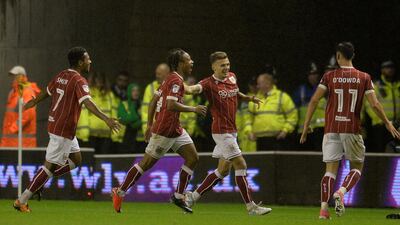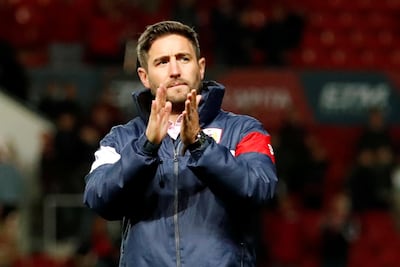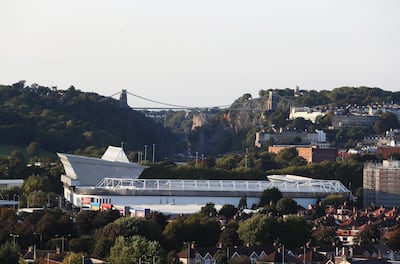Bristol City have just beaten Derby County 4-1 to cap a fine week following victory at Reading and a 3-3 draw at big spending Wolves.
Their redeveloped Ashton Gate home, with its 27,000 red and white seats fit for Premier League football, is a happy place. Fans are enjoying playing up to the country-bumpkin stereotype by singing along loudly to the Wurzels' anthem with it's inimitable line: "Your cheeks been gettin' redder from Charterhouse to Cheddar".
The first question from a journalist to City’s manager Lee Johnson, 36, is "you must be smiling from ear to ear?" to which he nods and says "I’m delighted".
Times like these are few at any football club, not least Bristol City, who hail from the ninth biggest urban area in England. Bristol, with a population of 646,000 is bigger than Leicester, Stoke, Norwich and Southampton, yet the home of City and Rovers has not had a top-flight football team since 1982.
_____________________________
MORE LONG READS FROM ANDY MITTEN:
Salford City and Stockport County: Proof football is thriving in Manchester beyond bright lights of the Premier League
Blackburn-Burnley rivalry: Enmity that runs deeper than simple geography
Rochdale: A down on its luck town with a club living large within its means
Huddersfield Town: A worldly club nestled into the Pennines, finding an edge on a budget
Blackpool: The demise of a club and the rise of its replacements
_____________________________
Fans hope that City, with their wealthy owner, redeveloped home and 19,000 average crowds which are bigger than Fulham, Birmingham City, Reading or Cardiff City, can change that.
But not everyone is happy. By the exit to the players’ tunnel, a boy waits in his wheelchair. Most of the City players have spoken to the young fan, but it’s a word with the manager that he really wants. Johnson arrives and is soon getting a talking to about where he’s going wrong and which players he needs to pick.
Johnson smiles. He’s heard worse. Midway through last season, his side lost 11 games in 12, dropping from fifth in the league to 20th. Fans turned against him, the abuse was pernicious.
“I went from the eighth best manager in the world under 40,” he recalls, “to the worst in Bristol’s City’s history in a few months.”
Backed by the board, he turned it around and kept his job as City finished 17th. Despite losing 26-goal on loan striker Tammy Abraham back to Chelsea, that strong form from the end of last season has continued this season.
"There a very good vibe around and it's a very forward looking club," says Gregor MacGregor of the Bristol Post. "A lot of money is being spent - over £45 million (Dh224.5m) on the stadium. More has been spent on the infrastructure, youth academy and scouting and analysis.
"The manager fits the model of a European coach; he’s very hands on. He likes to work with young players and oversee everything at the training ground.
"They've also been backed by Stephen Lansdown, an accountant by trade and now the billionaire owner of Bristol Sport (which owns the city’s rugby union and basketball teams).”
The Premier League is the dream, but it’s not the norm and never has been, with City’s last spell in the top flight - a four-year run from 1976-80 - famous for how it ended.
The club were relegated from first to fourth divisions in successive seasons and were in debt and facing a winding up order. Had eight players, known as the "Ashton Gate Eight" not torn up their long term contracts, Bristol City would no longer have existed.
It took until 1990 to get out of the bottom two divisions – finishing runners up to Bristol Rovers. In 1991, young Arsenal striker Andy Cole arrived as a £500,000 record signing.
“I didn’t have an agent, but went with my brother to negotiate,” recalls Cole. “He told me not to sign anything. I was impatient and signed a three-year contract straight away, worth £450 a week. I got a signing on fee of about £20,000. I thought I was minted.
“Bristol City was what my career needed. I was scoring goals in front of 15,000 and playing with experienced pros like Leroy Rosenior, Mark Aizlewood, Russell Osman and the Polish magician, Jacki Dziekanowski. That’s all I wanted. People started talking about me.”
Cole found out that Newcastle United were interested in making him their most expensive signing when he left a launderette near his apartment and found a sticker on his car windscreen asking him to call a teammate. That led to a conversation with Newcastle manager Kevin Keegan, who showed his determination to sign Cole by getting his name wrong and calling him Adrian.
The pair would have a productive partnership at Newcastle and now get on well. Bristol City were £1.7 million better off, but they have flitted between England’s second and third tier for 27 years.
Lee Johnson’s father Gary did better than most managers, managing the side to promotion to the Championship and a fourth place finish and Premier League play-off.
That is as close as they have been, though they spent a considerable amount on big name players, including goalkeeper David James in 2010, to win promotion, yet the team were relegated in 2013.
City changed their philosophy after that, promoting young players and using statistical analysis from a revamped scouting system, with half a dozen young maths graduates crunching numbers and scouting information from around Europe.
Niclas Eliasson, a Sweden under 21 international winger with a Brazilian mother was one whose statistics stood out.
“I was playing for Norkopping in Sweden when Bristol City approached me,” he says. “I looked around the city and liked it immediately. The club feels like a family too, the football is attacking and we try to keep the ball.”
It was the "Moneyball" approach to buying players which led City to sign two players from second tier Angers in France, both for club records. Jonathan Kodjia signed for £3.25 million in 2015 – and was sold to Aston Villa for £15 million twelve months and 20 goals later.
In June 2017, City signed Senegal striker Famara Diedhiou for £5.3m, another sign of their ambition in a league of bigger rivals, many of them with the benefit of parachute payments following Premier League relegation.
It’s a competitive division where spending doesn’t guarantee success. Huddersfield Town won promotion last season with the 13th biggest wage bill in the 24-team division. Aston Villa, with the biggest, finished 13th.
Not every signing is a young European scouted because of impressive statistics. Luke Steele an experienced goalkeeper, signed recently as No 2.
“I had an opinion and perception of Bristol City because I’d played against them so many times,” he says. “And it was totally wrong and formed from three hours once a year. There’s an incredible attention to detail going on here, from the warm up rooms to the physio rooms.
"There’s great detail in training, with a drone watching us every day to film it. I’ve never seen that before. But a lot comes down to the quality of the players and there are good players here. It’s not the Bristol City that I had in my head, which was one lacking the quality I see.”
Two hours before kick-off, Rob from the fanzine One Team In Bristol stands by the statue of club legend John Atyeo, selling the 220th issue of a publication he’s been editor of for 25 years.
"The mood is very positive,” he says as he’s helped out by daughter Charlotte, 11 days after she became a mother. “The stands have been rebuilt and we like it. We didn’t want another anonymous bowl like other clubs.
"We had tried to build a new stadium over the road for years, but it kept being turned down. We need to fill it now because there’s no point building stands if they stay empty. The club are trying to encourage more fans by allowing season ticket holders to bring a friend for £10 for certain games.”
Crowds have hit a 38-year high and Rob says that he hopes to “consolidate in this league. A top six place would be fantastic, but anywhere between sixth and twelfth would be brilliant.” FourFourTwo magazine tipped City for a 22nd place finish and relegation.
Relegation would mean League One and sharing a division with neighbours Rovers for the first time in 17 years. It’s clear from speaking to fans that the rivalry with Rovers is particularly nasty.
“Any time we beat Bristol Rovers,” says fanzine editor Rob when I ask him of his high point as a City fan. “It was very intense when it was a rivalry, but it’s 17 years and over 6000 days since they’ve been above us in the league so it has waned a little.
"There’s a very strong dislike between us. They accuse us of buying our success. We’ve got the 14th richest chairman in the country, worth £2.1 billion. He’s an accountant by trade and careful with his money.”
The River Avon splits the support.
“Anything north of the Avon is predominantly Rovers and anything south mainly City,” Rob says. “And we’re a much bigger club.”
And yet while City are a big club, they should be for a city of their size.
“Football is not as big a deal here as it is in Manchester, where I lived for 11 years,” says fan James Bolam in a cafe which forms part of the redeveloped Ashton Gate. “It’s not the talk of every office like in Manchester or the big northern cities, but then the origins of football are in northern England.
"Yet it still feels special to be a City fan, even though we should have done better than we have. We took over 3,000 fans to Reading last week, we should be a Premier League club, but we’ve been saying that for years.”
Inside the ground, newspaper headlines adorn the walls near the pressroom, with a play-off defeat at Wembley in 2008 prominent.
“That was a low point,” Rob says. “We’d had a great season. We were a goal away from the Premier League and my head couldn’t quite get around the fact that we might become a Premier League team. I felt dizzy before the game.”

It wasn’t the first Wembley mishap. Defender David Moyes missed the crucial penalty in the first shootout to decide a cup final at Wembley – the 1987 Football League Trophy Final.
“I'd been practising penalties in the week before the game and smashing them in left right and centre,” Moyes says. “I was in form. I was to take the sixth penalty kick. I had cramp in both legs. I trundled it down the middle. It was a terrible penalty.
"My family and friends were all there. We lost. If you're going to miss a penalty, then you might as well do it at Wembley in front of everyone you know, but Bristol City are a great club and I have happy memories from there.”
From Moyes to Ralph Milne and Andy Cole, the number of players who would go and work at Manchester United - Bristol City’s opponents in the 1909 FA Cup final during their only other top-flight spell - was significant.
Former United and AC Milan striker Joe Jordan managed the club and still lives in the city, attending occasional games. He was at top-flight Southampton as a striker when Bristol City approached him in 1987.
“I didn’t jump at the offer,” he remembers. “I’d not played in the second division, let alone third. But I had to expel a few demons and accept where I was rather than where I wanted to be.”
He drove to Bristol with wife Judith. "It was a fine city,” he says. “And Ashton Gate was a fine football ground.” He would become player-manager and then manager in two sustained spells.
Jordan is still in love with the city. “It has never crossed my mind to live anywhere else. Even when I worked elsewhere like Spurs or Portsmouth, I’d rent a flat and the family stayed in Bristol.”
But is it too nice? James Bolam thinks it might be.
“We attract players because it’s a nice place to live. But players enjoying the city too much isn't necessarily right for a successful football team. It’s a great city, though, culturally diverse and rich. And you need to be rich to live in a lot of Bristol. House prices are very expensive.”
They are a little cheaper in the mainly working class south side of Bristol, where Ashton Gate sits, only a mile from the iconic Victorian Clifton Suspension Bridge which spans the Avon Gorge. Banksy, the artist is Bristolian. Musically, Massive Attack are the best known band from the city that also produced The Korgis, Bananarama, Way out West and Tricky.
“There’s Portishead too,” adds Bolam, “but Andy, the DJ is a Gashead (Bristol Rovers fan), so we won’t talk about them."
The game starts and the vocal fans in the corner Section 82 (named after the year the club nearly went under) come to life. “We’re Bristol City, the city is ours,” they holler. They sell stickers, with proceeds funding City flags.
Derby, fresh from hammering Hull City 5-0, are among the promotion favourites and look it when they are leading at half-time. Being behind at the break doesn't stop the public address announcer having a little laugh when he reads out that Bristol Rovers are losing. City surge back, scoring four times.
“Ole, ole, ole, Bris-tol, Cit-y!” they sing. The crowd of 19,473 (with 1,553 Derby fans) is another impressive one, but there are still 8,000 empty seats, space for the club to grow. They make use of their substitutes too.
“The tempo is so high in this league that teams tend to use all their subs in every game,” explains Steele, who spent four years at Manchester United. “The speed is so fast that the midfielders work so hard that you have to change at least one of them.”
The best player is local midfielder Bobby Reid. “A goal thief” is how his manager described him after the 24-year-old appointed himself as penalty taker. “He’s Bristol City through and through. Come through the academy. Been here since the womb.”

Former Leeds United, Manchester United and AC Milan striker Jordan was in the crowd and impressed by the set up.
“Bristol City needed a new stadium and permission was consistently refused,” the Scot says. “Ashton Gate had fallen behind that of rivals, but the club have extended and expanded it. It was needed and the owner has done well and backed the club.
“This season has started well but it’s early days. The city of Bristol could certainly do with a team in the Premier League and it has long frustrated and amazed me that it hasn’t happened.
The city could handle it, the catchment area is big enough and Bristol City is geared towards it.”
“We don’t set targets,” Johnson says when asked what will make a successful season. “We talk about blocks of games, six or seven. Sprints rather than a marathon. International football allows those natural breaks, but I’m delighted to pick up seven points this week against the standard of opposition we’ve played.
“We’re ready for a successful season. We can't get ahead of ourselves, but we have goal threats all over the pitch and our strength is in our unity. We have 22 players who I trust impeccably.”
Those players have made Bristol City the top scorers in the Championship. “I like attacking football,” says Johnson, who played under his father at Ashton Gate. "We could have gone gung ho and ended up with eight attackers at the end.”
Four goals would suffice and things get better when the team beat Premier League Stoke City 2-0 in the League Cup.
“There’s a buzz around the place,” assistant manager Dean Holden says. “We’ve got quality all over the pitch, especially in attack. We’re aggressive, we take the game to opponents, we’re settled and the fans are really behind us. Makes a change from earlier in the year when me and the gaffer were being called Dumb and Dumber.”
For the moment, Holden and Johnson are intent on savouring and extending their current run and in the words of that Wurzels' song, "merry be". Very merry indeed.




